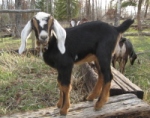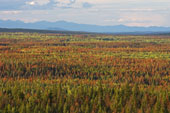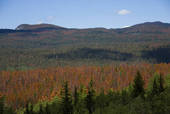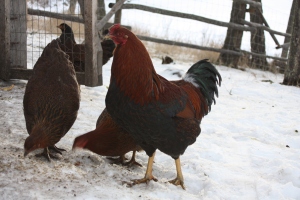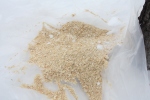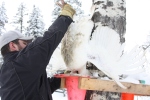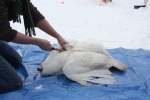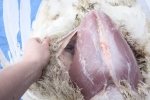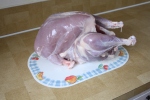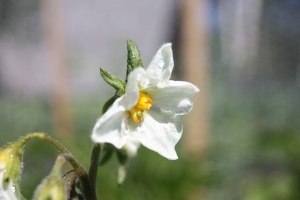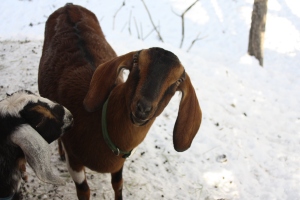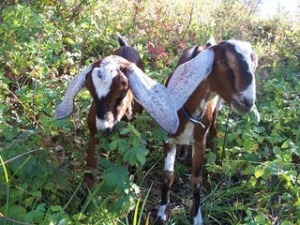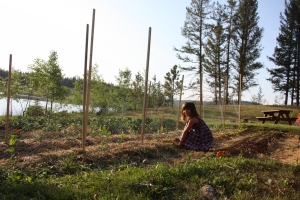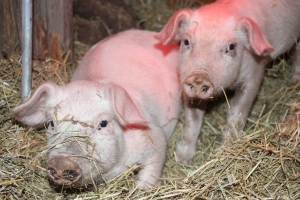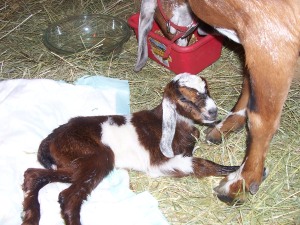January always means seed catalogues for me. I love seed catalogues. I live in a zone 3-4 and it can sometimes be a challenge to grow here. Our season is short, but I almost always find something new to try.
We can’t plant in the ground up here until the end of May, so I don’t plant my seeds indoors until early March. That gives me some time to get my orders in by the end of February. I am always so grateful for the catalogues this time of year because a winter person, I am not! When I drool over seed catalogues I can almost feel the warmth of the sun if I really really try.
So back to what I will be ordering this year… One of my favorite places to order from is Salt Spring Seeds, and this year they are offering a Zero Mile Diet Seed kit. I have always wanted to try these plants and this is an economical way to do it.
‘This kit is for gardeners or groups of gardeners eager to become more self-reliant in food. The 13 seed packets contained in it are Red Fife Wheat, Purple Barley, Hulless Oats, Wren’s Abruzzi Rye, Golden Flax, Quinoa, Amaranth, Heritage Bean Mix, Carlin Soup Pea, Winnifred’s Garbanzo, Russian Kale, 20 Lettuce Blend, Ardwyna Paste Tomato. Included in the box, apart from the seeds, is a 20-page comprehensive growing and recipe guide. A treasure trove of possibilities for the ardent grower!’~Salt Spring Seed Company
Tomatoes
Chiapas Wild
Orange, currant-size with excellent flavour. Tiny leaves. Sprawling plants. 5-foot vines. Prolific. Ancient variety. Doesn’t ramble like some wild varieties. Great producer. Disease tolerant.
New, Canadian Collection
Salt Spring Sunrise: red, midseason. Savignac: mid to full season. Quebec 314: large cherry size. Doucet’s Early Market Quebec: early. Dufresne: full season.
Bali
Medium, very ribbed tomato, marbled pink, yellow and red. Juicy, unique, complex flavour. Huge producer. Beautiful slicer. Looks like flower petals. From Bali. Rare.
Ardwyna Paste
Long, fat and tapered. Good in large containers and greenhouse. Excellent flavour for sauce. Few seeds. Early and abundant production.
Letuce
Berenice
Green Oak leaf type with dense heads. Stands up to heat well, so expect full season production.
Dixter
Burgundy/Red Romaine type, which is slow to bolt, has great texture and can be used in baby leaf production.
Rouge Grenobloise » a sanctuary seed
A French Heirloom.This Batavian type produces a good sized head, with a fine red colour. Excellent full season production and cold hardy.
This heirloom dates back to the late 1800’s. It has a bronze/green colour, which is a real stand out. This is an ideal summer variety.
Trocadero » a sanctuary seed
A rare loose butterhead type, with compact heads, it stands well in all conditons. A mid-green colour.
De Morges Braun » a sanctuary seed
Very rare Romaine type from Switzerland. Has apple green centers with pink/bronze outer leaves.Tolerates all weather conditions and has excellent flavour. A stunning salad addition.
Oaky Red Splash
Grows tall with red splashes on a bronze background. Heat tolerant. Pink stems. Another winner from Frank Morton.
5 Colour Silverbeet
The original heirloom from Australia, with the leaf colours pink/yellow/orange/red and white. Excellent as baby greens or at full maturity. A real stand out for flavour and in the garden.
January King Cabbage
(Brassica oleracea) Hardy winter cabbage that withstands severe frosts. Crisp, crunchy, green/blue heads have excellent flavour.
Spinach
Lush greens, high in iron. Best planted in spring or fall.
Spice-It-Up Salad Blend » certified organic
Red mustard and arugula add excitement to this tangy mix. Frilly mizuna and a selection of tasty lettuce round out this blend. Summer salads never tasted this great!
Russian Red Kale (aka Ragged Jack) (Brassica oleracea)
Easy to care for and extremely winter-hardy. Beautiful, purple-veined variety. Flavour improves after the first frost. Delicious in winter salads or steamed. Very high in many vitamins and minerals. Planted by July, kale gets to a good size before cold sets in. Use spring flower buds like broccoli.
Four Kale Mix
(Brassica oleracea) A mix of our 4 favourite kales: Red Russian, White Russian, Frilly and Squire.
Rainbow Chard (Beta vulgaris var.)
Extremely popular, recently introduced variety.
Blue Pod Desiree
Large rectangular soup pea similar to Holland Brown but has vibrant purple pods that making picking a delight. Makes delicious, full-bodied soup.
Summer Pea » certified organic
Great shelling bush pea. High yields. Withstands extended summer heat. Self-supporting.
Beka Brown
Beautiful golden yellow bean. Always early and prolific. Great flavour. Matures early to mid-August.
Long Island Cheese
(C. moschata) Large, buff-coloured, flattened, ribbed shape. winter keeper. Tender skin and thick, flavourful bright orange flesh, soft when cooked.
Sibley Hubbard (C. maxima)
An heirloom variety winter squash, produces 8 to 10 pound elongated football shape fruits. Slate blue colored skin, with some orange tinge on soil side. Very hard skin. Excellent storing squash. Said that they taste better if you store and wait until after New Year’s to eat them.
Styrian Pumpkin (Cucurbita pepo styriaca)
Naked (hulless) seeds are eaten raw or toasted. Sprawling plants produce about six 15-pound pumpkins. Light-coloured flesh can be used in zucchini recipes, pumpkin soup and stir-fries or be grated into winter salads. Will ripen even in cool wet summers.
Table King Acorn
(Cucurbita pepo) 70-90 days. Gray-green ribbed, 2-pound fruit. Thick, pale-orange flesh. Excellent flavour gets even better with storage. 5-8 fruits per plant.
Round Zucchini (C. pepo)
Round ball shape. Nice green skin with some creamy white stripes and flesh. Good production on bushes that don’t spread, so ideal for home gardens and market speciality growers. Good steamed when small and excellent for grilling once they reach baseball size.Mature fruit can be stored as a winter squash.
St. Valery Carrot
Special heirloom from the famous Vilmorin Garden in France. Very popular in the late 1800’s and earlier. Expect bright orange 10-inch roots, that are smooth and very sweet. Rare.
Laurentian Rutabaga
Popular Canadian variety with deep purple crown and cream yellow base. Uniform 5-6 inch almost neckless roots are very cold-hardy and excellent keepers. Pale yellow flesh. Sweet refined taste and texture.
Onion: Perennial Bunching (Allium fistulosum)
Also called Welsh Onion. Great for salads and cooking.Bulbs are small and store well.Leave some in the ground over winter, for very early green onions.
Winter Party Onion » certified organic
(Allium cepa) Consistent quality storage onions in mix of red, white and marbled colors with red, rose or white skins.
Early Wonder Tall Top Beet (Beta vulgaris)
60 days. Leaves dark green with maroon tinge. 18 inches tall. Dark purple 3″ flattened beets, good for greens and early beets.
Detroit Red Beet (Beta vulgaris)
Highly esteemed, reliable, nearly globe, dark beet. Main crop canner for home gardens. With mulch, will winter in the ground at the coast. Heirloom from 1892.
Chantenay Carrot (Daucus carota)
Especially suited for heavy soils. Rich orange colour, very sweet and juicy. Large stump-rooted variety.
Harris Model Parsnip (Pastinaca Sativa)
Plant direct from end of March to early July and leave in ground mulched until after first frost when this delicious root becomes sweeter. Bright white and about ten to twelve inches long the Harris parsnip is ideal for oven roasting or tasty winter stews.
Potatoes
I ordered all my seed potatoes from Eagle Creek Seed Potatoes and was very pleased with both the service and quality. I tried six varieties and all were fantastic. I experimented with fingerlings potatoes and we all loved them. They are very flavorful, and they were fantastic in stews with skins on. They have also kept well. We stored them all in paper feed bags with a fan to circulate the air in our cement basement. We will be building a proper potato bin this year in the root cellar, but the bags were just fine. I haven’t yet decided which potatoes to try this year.
Looking forward to spring!




Filed under: Gardening | Tagged: Gardening | 1 Comment »


